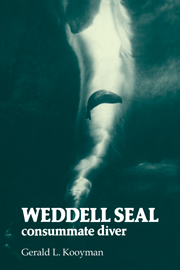Book contents
- Frontmatter
- Contents
- Preface
- Dedication
- Map
- 1 McMurdo Sound
- 2 The Weddell seal
- 3 Breeding, birth, and growth
- 4 Cold
- 5 Diving behavior: Poseidon's pride
- 6 Physiology of diving
- 7 Food habits and energetics
- 8 Under-ice orientation (summer day – winter night)
- 9 Distribution, abundance, and mortality
- 10 Future prospects
- References
- Index
- Frontmatter
- Contents
- Preface
- Dedication
- Map
- 1 McMurdo Sound
- 2 The Weddell seal
- 3 Breeding, birth, and growth
- 4 Cold
- 5 Diving behavior: Poseidon's pride
- 6 Physiology of diving
- 7 Food habits and energetics
- 8 Under-ice orientation (summer day – winter night)
- 9 Distribution, abundance, and mortality
- 10 Future prospects
- References
- Index
Summary
What is past is prologue.
Shakespeare, The TempestDuring the heroic era of the late 1800s and early 1900s, the killing of seals was a necessity if polar exploration were to go forth. Expeditions lasted two or three years, and it was impossible to bring enough fresh meat for the entire time. Also, dog teams were frequently brought for overland transportation and they required a considerable amount of meat. Seals and penguins were often a viable emergency ration. In several instances, exploratory parties ran out of supplies and had to rely on local resources. Two of the most dramatic examples are Scott's northern party expedition in 1912 and Shackleton's entire expeditionary force in 1915.
On January 8, 1912, six men disembarked the ship Terra Nova in Terra Nova Bay on the northern coast of the Ross Sea. The ship was unable to return for them, and they had to overwinter unexpectedly in a cave on Inexpressible Island. They did not have nearly enough food supplies, and they survived because of the penguins and seals they killed. On November 7, 1912, they reached the main camp after about one month's travel over the coastal sea ice.
Perhaps the most dramatic polar experience in history was that of Sir Ernest Shackleton and his men. The ship Endurance was beset in the Weddell Sea and on October 24, 1915, the hull–crushing forces of the sea ice caused the ship to sink.
- Type
- Chapter
- Information
- Weddell SealConsummate Diver, pp. 121 - 126Publisher: Cambridge University PressPrint publication year: 1981

